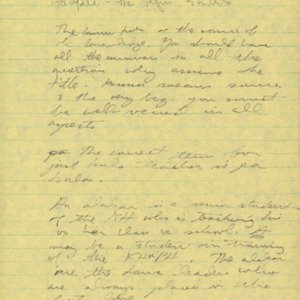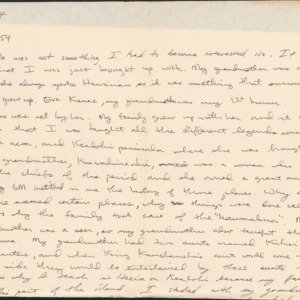Frank Kawaikapuokalani K. Hewett
Title
Frank Kawaikapuokalani K. Hewett
Subject
Frank Hewett, a faculty member of the Windward Community College, is the kumu hula of the Kuhai Halau O Kawaikapuokalani Pa ‘Olapa Kahiko
Description
The greatest hardship for me was to live under the strict kapus I trained under for twenty years. But I love to dance and the people that taught me were so inspiring that I have no regrets. When I dance I offer certain evocations to ask certain spirits to become a part of me so that they may be happy again in coming back to life through me. That’s what gives me great joy because that’s what the hula is all about.
My grandmother Eva Kana‘e was a dancer so the hula was something that surrounded me as I grew up. She spoke Hawaiian and it was through her that I was taught the foundations of my hula and the history of He‘eia and Kealohi. I spent eighteen years with my grandmother and she instilled in me a great love for hula kahiko and hula ‘auana.
After my grandmother I spent a year with Edith Kanaka‘ole. Aunty Edith taught me how to give. I remember one time she was asked why she taught the hula to the Haole and she replied ‘Because, we are all God’s children.’ She made me aware of the disadvantages of being too generous but she inspired me to give out because that’s why I was given the knowledge.
After Aunty Edith I spent ten years with Aunty Emma deFries who took me to the very depth of the hula, back to its very beginnings and foundations. She said that the beginnings of the hula is the essence of our people, and she explained the workings of the kapus to me and the symbolism of the different colors and plants in nature.
I began to teach in 1978 in He‘eia and Kealohi because my family has roots there. I don’t train performers; my students have to be content with just gaining knowledge. Hawaiians are not lazy like we have been stereotyped and that’s what I’ve been trying to do, break the stereotypes that brand the Hawaiians.
The biggest problem we have today is the broad use of the title of kumu hula. The people of today are training for one or two years when in fact they should be training for ten to twenty years. There has to be definite divisions in the hula because the title of kumu must carry dignity. There has to be an orderly, credible procession up the ranks.
My opinion is that there should be four distinct levels of study in the traditional hula. The premier level should be the kumu hula and the people within this division should be sources of knowledge within themselves.
The kumu hula should be well- versed in all aspects of the hula. Below this division should be the hula teacher who would be allowed to teach only with his or her kumu hula acting as a mentor. They would be designated as pa hula or teachers of hula. The third division would consist of senior students and they would be called alaka‘i. An alaka‘i would be a student in training with either a kumu hula or a pa hula and they would act as the dance leaders on the floor and would be placed in the front line. The fourth division would be filled with beginning students and they would be called ho‘opili because they are strictly mimics of their teachers.
Hula is not just dancing and chanting but a deeper spiritual aspect which must be accrued by the student and cannot be picked up in one or two years. In the days of our ancestors, a student would train one five-year period in the ho‘opili division and one five- year period in the alaka‘i division. This five-year period was called a palima and two palima were designated as a hale ‘umi. The kumu hula would ‘uniki each student to the next level and only the best students after completing a hale ‘umi of training would be chosen by the kumu to be trained as kumu hula.
By custom the pa hula would only move up to the level of kumu hula after the passing away of their kumu. It was an entire social system of selection that hardly exists today. I think what’s starting now is that anybody can stand up and say they’re a kumu hula and if it continues the hula will be demeaned and become common. There is a need for the kumu hula to come together and set standards and express concerns about what is happening in the hula world.
Today it is the dance motions in kahiko that command all the attention because the Hawaiian of today does not understand the language. That’s why today’s motions are so vigorous and exaggerated. The dancers are trying to tell the story totally through the motions of the dance. Hula kahiko must be passed down in its entirety from generation to generation because only then does the culture that the kahiko is expressing remain intact. Hula is a religious ceremony to the Hawaiian gods and goddesses of our ancestors and we can’t get away from that. I think creativity can be allowed in the hand movements but the five basic foot movements must be left alone. Each movement symbolizes something important and if they are embellished then we have blurred the lines.
My grandmother Eva Kana‘e was a dancer so the hula was something that surrounded me as I grew up. She spoke Hawaiian and it was through her that I was taught the foundations of my hula and the history of He‘eia and Kealohi. I spent eighteen years with my grandmother and she instilled in me a great love for hula kahiko and hula ‘auana.
After my grandmother I spent a year with Edith Kanaka‘ole. Aunty Edith taught me how to give. I remember one time she was asked why she taught the hula to the Haole and she replied ‘Because, we are all God’s children.’ She made me aware of the disadvantages of being too generous but she inspired me to give out because that’s why I was given the knowledge.
After Aunty Edith I spent ten years with Aunty Emma deFries who took me to the very depth of the hula, back to its very beginnings and foundations. She said that the beginnings of the hula is the essence of our people, and she explained the workings of the kapus to me and the symbolism of the different colors and plants in nature.
I began to teach in 1978 in He‘eia and Kealohi because my family has roots there. I don’t train performers; my students have to be content with just gaining knowledge. Hawaiians are not lazy like we have been stereotyped and that’s what I’ve been trying to do, break the stereotypes that brand the Hawaiians.
The biggest problem we have today is the broad use of the title of kumu hula. The people of today are training for one or two years when in fact they should be training for ten to twenty years. There has to be definite divisions in the hula because the title of kumu must carry dignity. There has to be an orderly, credible procession up the ranks.
My opinion is that there should be four distinct levels of study in the traditional hula. The premier level should be the kumu hula and the people within this division should be sources of knowledge within themselves.
The kumu hula should be well- versed in all aspects of the hula. Below this division should be the hula teacher who would be allowed to teach only with his or her kumu hula acting as a mentor. They would be designated as pa hula or teachers of hula. The third division would consist of senior students and they would be called alaka‘i. An alaka‘i would be a student in training with either a kumu hula or a pa hula and they would act as the dance leaders on the floor and would be placed in the front line. The fourth division would be filled with beginning students and they would be called ho‘opili because they are strictly mimics of their teachers.
Hula is not just dancing and chanting but a deeper spiritual aspect which must be accrued by the student and cannot be picked up in one or two years. In the days of our ancestors, a student would train one five-year period in the ho‘opili division and one five- year period in the alaka‘i division. This five-year period was called a palima and two palima were designated as a hale ‘umi. The kumu hula would ‘uniki each student to the next level and only the best students after completing a hale ‘umi of training would be chosen by the kumu to be trained as kumu hula.
By custom the pa hula would only move up to the level of kumu hula after the passing away of their kumu. It was an entire social system of selection that hardly exists today. I think what’s starting now is that anybody can stand up and say they’re a kumu hula and if it continues the hula will be demeaned and become common. There is a need for the kumu hula to come together and set standards and express concerns about what is happening in the hula world.
Today it is the dance motions in kahiko that command all the attention because the Hawaiian of today does not understand the language. That’s why today’s motions are so vigorous and exaggerated. The dancers are trying to tell the story totally through the motions of the dance. Hula kahiko must be passed down in its entirety from generation to generation because only then does the culture that the kahiko is expressing remain intact. Hula is a religious ceremony to the Hawaiian gods and goddesses of our ancestors and we can’t get away from that. I think creativity can be allowed in the hand movements but the five basic foot movements must be left alone. Each movement symbolizes something important and if they are embellished then we have blurred the lines.
Hālau
Kuhai Halau O Kawaikapuokalani Pa ‘Olapa Kahiko
Hula Training/
Competitions
Eva Kana'e
Edith Kanaka'ole
Emma deFries
Edith Kanaka'ole
Emma deFries
Citation
“Frank Kawaikapuokalani K. Hewett,” Nā Kumu Hula Archive, accessed July 3, 2025, https://nakumuhula.org/archive/items/show/27.







